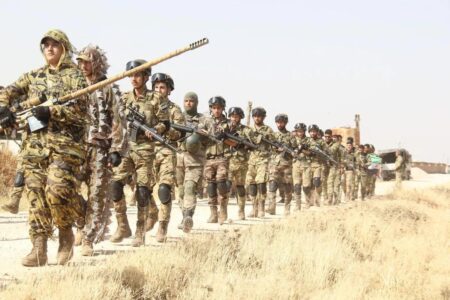
ISIS and the Syrian Camps
Although ISIS’s territorial “state” may have been dealt its final defeat in the village of al-Baghouz in eastern Syria nearly three-and-a-half years ago, the terrorist group remains very much alive.
In the past two weeks alone, the group has been responsible for at least five attacks in northeastern Syria, while three suicide vehicle bombs and several ISIS suicide bombers were intercepted en route to conduct additional attacks.
Days after the latter incidents, an intelligence-driven raid by the Syrian Democratic Forces resulted in the largest weapons seizure from ISIS in at least two years – including dozens of assault rifles, more than 100 rocket-propelled grenades and anti-tank rockets, as well as grenades, explosives and hundreds of thousands of rounds of ammunition.
These incidents were not just another reminder of ISIS’s persistent threat – they also served to underline that the group’s most powerful rallying cry today remains the mass internment of 56,000 women and children and detention of 12,000 male fighters in camps and prisons in northeastern Syria. ISIS’s own propaganda and recent statements claiming responsibility for attacks have all placed the goal of breaking women, children and men out from detention as ISIS’s number one objective.
Freeing prisoners has long been a matter of deep importance for “jihadists,” but for ISIS, it has been strategically vital. In 2012 and 2013, ISIS sustained a year-long “Breaking the Walls” campaign in Syria and Iraq, attacking multiple prison facilities and breathing new life into its transnational insurgency. That ISIS is already prioritizing the same targets in 2022 should serve as a stark warning of their intent.
Today, the Syrian Democratic Forces control a network of nearly 20 makeshift prisons across northeastern Syria, holding approximately 12,000 male fighters – 5,000 Syrian, 3,000 Iraqi and 2,000 from dozens of “third countries.” While an influx of British funding in 2021 and US defense spending in 2022 has improved the security of these facilities, they remain exposed to attack. As with ISIS’s major assault on the Ghweiran Prison in Hasakeh in January 2022, the prisons are also vulnerable to ISIS’s attempts to infiltrate Syrian Democratic Forces guards.
Ultimately, the fate of these 10,000 male detainees remains unknown, as few if any governments abroad are willing to consider repatriation, given the risk and associated costs. However, the challenge associated with the 56,000 women and children currently held in the al-Hol and al-Roj camps should be something that the international community can more realistically deal with. Of that number, 29,000 are Iraqi; 18,000 are Syrian; and 9,000 are from at least 51 third countries. At least 50% of camp residents are under the age of 12
Iraq’s government is engaged in a program of near-monthly repatriations and eligible Syrians are being returned to their communities as part of tribally mediated arrangements.
Since early-2019, at least 34 governments have repatriated some of their citizens from al-Hol and al-Roj. In the last year, at least 18 governments have conducted repatriation operations and this month, three more are planned. But still today, 9,000 third country women and children remain interred, in squalid conditions rife with disease, malnutrition, violence and extremism.
Of the 34 governments known publicly to have engaged in repatriating women and children, only three are from the Middle East: Saudi Arabia (two children, in 2019); Palestine (two children, in August 2021); and Morocco (specific details remain unconfirmed).
To put this into context: of the nearly 2,500 women and children repatriated to third countries since 2019, less than 0.2% were from the Middle East. And yet in reality, a sizeable proportion of third country nationals in al-Hol and al-Roj are from the Middle East.
Within international diplomacy in recent months – both in public and behind closed doors – the “detainee dilemma” has garnered significant attention and meaningful policy momentum. For the first time, there is a sense that a consensus is emerging that ignoring the problem is no longer an option, and that action on repatriation is now a must.
While individual governments are approaching the issue in their own ways – some openly and some more quietly – the situation for governments in the Middle East appears remains largely frozen. This is not sustainable.
When ISIS dramatically expanded across Syria and Iraq in the summer of 2014, killing thousands and threatening a genocide against Iraq’s Yazidis, the world mobilized like never before. Within weeks, an international coalition of unprecedented scale was formed to combat the terrorist group — that included 10 regional governments: Bahrain, Iraq, Jordan, Kuwait, Lebanon, Oman, Qatar, Saudi Arabia, United Arab Emirates and Yemen. At that pivotal moment, the world united under a shared goal: to fight terrorism.
We face a similarly crucial moment today, as the global coalition seeks to turn a tactical victory (the territorial defeat of ISIS) into a strategic victory. That challenge cannot be accomplished without the participation of the Middle East and so long as the al-Hol crisis remains unresolved, only ISIS stands to benefit.
Source: Aawsat





